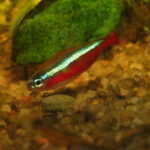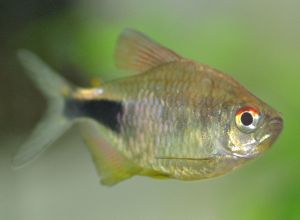Green Neon Tetra Fact Sheet
The “Green Neon Tetra”, “Paracheirodon simulans“, is closely related to the Neon Tetra, Paracheirodon innesi, and the Cardinal Tetra, Paracheirodon axelrodi. It is not as popular as its two gorgeous cousins although it is also a stunning fish. In our shop, by far the most popular tropical fish is the Neon Tetra. The Cardinal Tetra is less popular despite being one of the most beautiful fresh water aquarium fish, its higher price puts some people off. I would suggest that it is only the existence of its two close relatives in the aquarium trade that stops the Green Neon tetra being the most sought after tropical fish.
To my eyes, the Green Neon Tetra is not very green, but we have to call it something. Other common names are the “False Neon Tetra” and the “Green Tetra”. Other scientific names that have been used for this fish are “Cheirodon simulans” and “Hyphessobrycon simulans”.
If anything the Green Neon Tetra is slightly smaller even than the Neon Tetra. Its maximum size is reported to be about one and a half inches (4cm) long although I have never seen one much over half this size.
The Green Neon Tetra has a more restricted range than the Neon Tetra although it is not a threatened species in the wild. It comes from The Rio Negro in Brazil and Colombia, and the upper part of the Orinoco in Venezuela.
The red section of the Green Neon Tetra is shorter than that of the Neon Tetra, and a lot shorter than the Cardinal Tetra’s.
Water Conditions
In the wild, the Green Neon Tetra comes from very soft, acidic water at a temperature in the mid to high twenties in degrees C (the seventies in degrees F). These are the ideal conditions for this fish. It will adjust to neutral water with some hardness and a temperature of 24 degrees C (75 degrees F) and is fine in a community tank with small peaceful fish.
Avoid having a filter with excessively strong water intake because this fish is prone to get sucked in by strong currents, perhaps even more so than the Neon Tetra.
Food
The Green Neon Tetra is an omnivore and will eat normal fish foods of a suitable size. Small live food is good as is frozen blood worms.
Companions
The Green Neon Tetra is a schooling fish and the larger the number kept together the better. If there are not enough Green Neon Tetras to form a school, they will school with Neon Tetras and Cardinal Tetras.
Other appropriate companions are suitable sized peaceful fish such as Cherry Barbs, Penguin Tetras, PristellaTetras, and Corydoras catfish like the Peppered Catfish. If they are in a reasonable sized aquarium, they should be all right with Siamese Fighting Fish as long as the fighting fish is not one of the few that has learned to catch small fish.
I would be more cautious about putting Green Neon Tetras with fish like Red EyeTetras, Silvertip Tetras, Gold Barbs, Rummy Nose Tetras and Colombian Tetras although they may well be all right with young ones of these species.
I would not put them with any large or predatory fish.
Sexing
There is not much difference in appearance between the sexes of this species; when in breeding condition, the female in broader than the male.
Breeding
Green Neon Tetras need water similar to the waters they live in in the wild; extremely soft water with a pH of about 6 and a temperature of around 77 degrees F (25 degrees C). Ideally the water should be highly stained by the tannins from peat, in subdued light, shaded by plants.
The Green Neon Tetra spawns in a school although in the actual act of spawning one female may be closely associated with one or more males.
Something like 130 eggs can be laid by each female. The parents should be removed after spawning. The eggs should hatch in 24 hours. The eggs are light sensitive so avoid much light.
The babies are very small and infusoria (protozoa) is necessary early on. As they grow, this can increasingly be supplemented with fine commercial fry foods. Green Neon Tetras can breed again after a couple of weeks.
Pest Fish
Although I find it a little difficult to view the Green Neon Tetra as an environmental vandal, normal precautions should still be exercised to prevent this fish getting into waters it is not native to.
Sources
I am grateful to the following places for information about the Green Neon Tetra: The Planted Tank, University of Michigan Museum of Zoology Animal Diversity Web and FishandTips.com.


